Any form of advertising and most particularly Out-of-Home advertising is most effective when the core message is created with an exemplary person in mind. The message speaks to the needs of the target customer. That’s when they feel understood and thus are driven to act and respond to it. There is no complicated science behind targeted messaging in OOH when you know who you talk to. Know your audience and adjust your language accordingly. It can, however, be an impossible task if you don’t possess this knowledge.
Targeting is the focus of this article! We’ll be walking you through simple and direct steps to identify and flesh out your target audience. In a sea of heterogeneous consumers who visit your store, it can be a challenge to identify a particular customer group. You don’t have to please everyone. This is a key understanding in appealing and inviting segments of your customer base who will stay loyal and provide a consistent stream of income. Narrowing down your focus will ensure more ideal customers come to your business, ensuring your target audience is cohesive and easier to capture.
The first step in identifying a customer segment for marketing purposes has already been taken during the development stage. What does your product or service do and which problem does it solve? Answering this question as specifically as possible will tell you who would buy and use it. Note that buyer and user are not always the same person. We start by establishing the target market, then narrowing it down to segments within the market most likely to need the product and respond to your company’s identity and message. Once you have a target audience in mind, the task of physically finding it and reaching out comes next.
Let’s take a look at these steps in more detail.
What is the purpose of your product?
What problem does it solve? A fast-food restaurant focuses on speed and caters to people who want to get a quick bite to continue with the rest of their day. In this instance, the target audience doesn’t emphasize nutrition or the in-restaurant dining experience. Advertising anything price, taste and speedy service is what brings the most people through the door. There may be some within the customer base who care about the higher up aspects, but they are mere tangential and not target groups. Remember, you don’t have to please everybody.
On the other hand, organic food targets the conscious eater willing to spend more as long as they can be sure about the ingredients. They know the increased standards have a cost.
What is the purpose of your product should be easy to answer. As simple as it is, many businesses neglect the obvious. Doing a little soul searching on what your product is and what problem it solves directs you to the next question to be answered.
Who wants to buy your product?
Be as specific as possible. If you sell sports equipment, which age group or demographic did you have in mind when you developed product, design, and features? If you own a restaurant, which cuisine do you cook? Perhaps you are the best address for curious people with a taste for something new, or your patrons love the traditional dependable plates you have served since the beginning.
Identify which specific segment of the broader market your product serves, then align your advertisement to them. The best strategy is to create an exemplary buyer persona. Give them a name and as much of a backstory as you can think of. What are their likes and dislikes, what is their day-to-day life like, and what do they aspire to? Think about how an Oscar-worthy actor would prepare for a role. Then speak their language. The more familiar you get with your target segment, the more spot on your message will be.
What is the physical location of your target audience?
Which do you think makes more sense, placing a deal centric car dealership advertisement at a bus station, or by the highway? Most people who use public transportation do so because they don’t own a private vehicle. If the public transportation in your area is known for inconveniences, the rider might be susceptible to an ad for inexpensive cars. The person frequenting the highway already has a car, but they might be receptive to an upgrade in convenience or consumption efficiency. At times the price of gas can break the bank, am I right? This little example highlights target market segmentation by physical location.
Establish where your target audience is likely to be. Is your product connected to a current trend? Are you selling the latest in fashion? Besides shopping malls, advertise near a well frequented beauty salon or the hottest clubs and restaurants in town. Just like FOMO (fear of missing out) is so yesterday, you do not need to be at every potential advertising location. Being selective about location can help you avoid wasting money on audiences who do not care about what you have to offer.
Which target audience is connected to your location?
It’s important to establish where your target audience is within the city. But it’s also important to be aware which audience is connected to locations you already have influence in. Perhaps you’ve noticed that your store-front ads haven’t shown much success in drawing in new customers. This is likely because your target audience isn’t strictly local to your part of town. And you can’t rely on passers-bys alone.
Even if this is the case, you can still use your digital signage to advertise and generate a profit. An option is to rent out your digital signage ad space. That is, if you know which customer type is most frequently around. Pay attention to the surroundings of your display or billboard. This is a critical part of your sales pitch promising greater success to whoever buys your advertising space. If they find the ad on your display to be working, they’ll buy again. This profit could allow you to advertise your own content in parts of the city where another portion of your target audience is.
McDonald’s “Follow The Arches” campaign is an ideal example of how powerful location-based advertising can be.
OnSign TV can help!
Once your target audience is identified and a buyer persona is developed, the next step is to create content relevant to them. By getting to know your ideal customer persona, your brainstorming sessions yield higher quality results. With a message in mind and ready to bring it to reality, you dive into the technical aspects of content creation. These OnSign TV articles can help you with this task:
- 6 Main Tools To Build A Digital Signage Campaign
- 5 Engaging Digital Signage Uses
- 3 Tips for Creating Effective Digital Signage Content
Use digital signage software to convey your targeted messages with ease, at the right place, at the right time. Try out the OnSign TV software for free and see for yourself the benefits of having a digital signage management system on your side.








